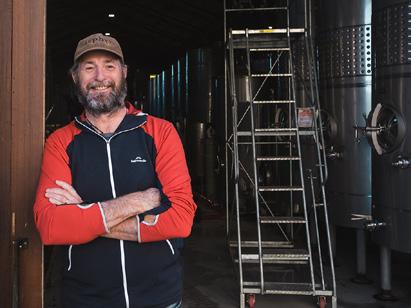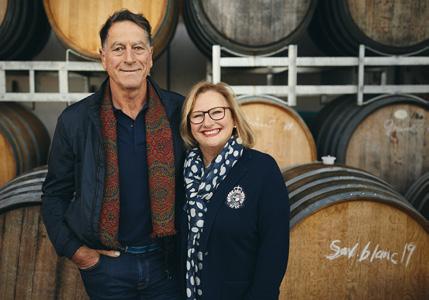
17 minute read
Viticulture Benchmarking
Benchmarking 2020 “Underlying industry Profits up and outlook ‘cautiously optimistic’ confidence however is
SOPHIE PREECE still positive MARLBOROUGH GRAPE growers enjoyed a leap in yields and profits for the 2020 season, despite the complications pruning costs were higher as a result of underpinned by of a Covid-19 harvest. The 2020 Marlborough Vineyard Benchmarking report, which uses a 30-hectare vineyard that loss of seasonal labour, which will strong demand model, indicates profits of $11,910 per hectare before tax, which is up 37% on 2019 and a 16% increase on the average profit from 2015 to 2019. be revealed in the 2021 benchmarking report. for Sauvignon Blanc”
“The combination of the very dry weather right through Working harvest and low disease pressure, coupled with adequate expenses in the irrigation for most vineyards, led to good yields of excellent last year increased 2% on 2019, costing the model vineyard quality fruit,” says the report, which was commissioned $12,455 per hectare, up 15% on the 2015 to 2019 average. by New Zealand Winegrowers (NZW) and the Ministry Increases over the past five years have mainly been for Primary Industries (MPI), and undertaken by Fruition driven by increased wage rates, with the minimum wage Horticulture. increasing 20% between 2015 and 2019, while growers report
The model yield was 13.8 tonnes per hectare, up 10% on a consequent increase in other wage rates, says the report. 2019 and 6% on the 2015 to 2019 average, while Sauvignon “Pest and disease control costs have also been increasing Blanc yield was 14.9 tonnes per hectare, 6% up on 2019, although fungicide inputs were able to be reduced in says the report. “The earlier flowering varieties Pinot Noir, 2019/20 due to the very favourable, dry weather conditions.” Pinot Gris and Chardonnay rebounded after a poor year in Marlborough growers continued to invest in capital items 2019, up between 30% and 80% in comparison with 2019 during the season, including dams, tractors, machinery and due to greatly improved weather conditions for flowering utility vehicles, the report finds. “Some of the machinery and pollination.” Grape prices rose as well, with Sauvignon purchased is specifically to reduce labour expenses such as Blanc up 3% to $1,905 per tonne, which is 6% higher than the three-row sprayers, mechanical pruners and vine strippers.” 2015 to 2019 average, says the report. “Prices edged higher due to increased sales and high demand for grapes.” Across Exports up but future uncertain all varieties, the model average grape price was $2,020 per Three quarters of the growers surveyed in the 2020 tonne, up 4% on 2020 and 7% up on the five years previous. Marlborough Vineyard Benchmarking survey felt the
Greg Dryden of Fruition Horticulture says great climatic biggest risk ahead was the potential impact of Covid-19 conditions and yield potential outweighed the impact of on global wine markets, including the effect on the Covid, which was largely a stress factor that created “a lot of distribution chain and the supply-demand balance, says anguish” to begin with, but proved little hindrance once the the report. “At present they feel uncertain as to what harvest machines started operating. In fact, the rules around may happen six to 12 months ahead.” Sauvignon Blanc Covid made it easier for some to get on with their work, with export sales were up by 6% in June and 23% in July 2020, no distractions, he says. “People could focus on getting their compared to the same months in 2019, according to New crop off.” Zealand Winegrowers (NZW) export data. NZW reports
As harvest progressed, new stresses arose as people that all wineries are facing “increased uncertainty on considered labour shortages for pruning, with borders future sales in a world impacted by Covid-19,” says the closed to winter seasonal staff, says Greg. “But as the survey report. “But if supermarket sales continue at current went on that concern dissipated.” He notes that winter levels the signs, overall for the industry, are positive.”
The vineyard model for 2020 is based on production, income and expenditure information gleaned from 48 participating vineyards, with 12 in the Awatere Valley and 36 in the Wairau Valley, representing small, medium and large producers. Sauvignon Blanc is the dominant grape variety in the model, accounting for 80% of the producing area, followed by Pinot Noir, Chardonnay, and Pinot Gris. As well as collecting data, the report’s authors talked to growers about their outlook, and found they were “cautiously optimistic” regarding the year ahead, with forecasts of a slightly lower crop in 2021. The Covid-19 pandemic has had a “significant influence” on morale, with half the group “very uncertain” about their businesses due to the pandemic’s potential effect on the wine supplydemand balance, labour availability and expenses. “Most of the rest were more positive, and with a good result in 2020 they still perceive a good future,” the report says. The authors say most surveyed growers were budgeting similar prices to 2020, and many were hoping for an increase to reflect climbing expenses. “Underlying industry confidence however is still positive underpinned by strong demand for Sauvignon Blanc.”
Growth continues Vineyard development continues in Marlborough, with 1,500 hectares coming into production over the past two years, according to the New Zealand Winegrowers vineyard register. The 2020 Marlborough Vineyard Benchmarking report notes that 1.7 million vines were planted in the 2019/ 2020 season in Marlborough, with a mix of new plantings and redevelopment of existing vineyards over approximately 750 to 800ha.
Photo by Richard Briggs


NOURISHES AND STRENGTHENS THE PLANT, NATURALLY.
KENDAL® is a product line designed to help plants remain vigorous under hostile growth conditions. The exclusive complex of biomolecules developed with GEA 249 technology, increases the support to the plant system, promoting a better development and production.

Board Report
Marlborough winemaker elected as board chair

LABOUR ISSUES will be a “top priority” for the New Zealand Winegrowers Board, says newly elected chair Clive Jones, winemaker and general manager at Nautilus Estate in Marlborough. Proactive work has seen many companies get “ahead of the curve” when it comes to summer vineyard work, “so it does look like the next issue we have to resolve is vintage labour”, he says. “There is a lot of active involvement in that at the moment but we won’t know yet whether we have solved it until almost the start of vintage.”
Previous New Zealand Winegrowers (NZW) chair John Clarke has left big shoes to fill, having been on the board since 2006, chair since 2018, and “an integral part” of the New Zealand wine industry over the past 40 years, says Clive. “During his time on the board the New Zealand wine industry has made grand strides and has secured a strong international reputation for premium and sustainable wines.”
Clive’s own wine journey began nearly 30 years ago, and for the past 22 years he has been at Nautilus Estate. He was on the Marlborough Winegrowers Board for six years, three of them as chair, and joined the NZW board five years ago, becoming deputy chair in 2018. The governance roles have offered him a “much broader appreciation of the industry”, he says. “That exposure to meeting different people and working through different issues that you may not be facing yourself as a business is very valuable in improving your knowledge. And it ultimately reflects back into building skills that you can apply in your day to day work.” Industry interest in governance seems to be growing, he adds. “The fact that we had 12 people standing in the recent election is amazing.”
Clive is excited about the future of New Zealand wine, with exports on track to reach $2 billion per year by the end of this year, but says it is “imperative” the industry continues to work together to ensure ongoing success. “I believe the New Zealand wine industry needs diversity across region, variety and size of business to be strong. A cooperative and united approach, combined with an absolute focus on quality, has served us well in the past and must continue to ensure our success in the future.”
A “helicopter view” of the wine industry in a Covid-19 world gives a “pretty rosy view”, with export sales up, pushing the industry closer to that $2b mark. “But the separation between commercial retail facing and the premium on-premise fine wine is widening because that’s where the challenge is at the moment,” he says. “The Covid effect has impacted businesses very differently depending on their business model. Some are doing better than last year, but a significant number are finding it tough at the moment.”

Board Report - Q&A (NZW) new board members New Zealand Winegrowers introduced four new board members after the recent election. Winepress asks how they’ll help protect and promote the interests of New Zealand’s largest winegrowing region. Emma Taylor Emma is a consultant viticulturist based in Hawke’s Bay. What do you bring to the board? I have a passion for viticulture. The grapes we can grow in New Zealand cannot be replicated elsewhere and that is something we need to protect. There are always multiple challenges facing an industry, and every season we make innovations to adapt to challenges. I would hope that my knowledge of viticulture, connection with growers, experience with water issues and understanding of research would bring a practical aspect to decisions made around the table.
How can the NZW board balance the interests of smaller regions with the needs of Marlborough’s industry? This is always a challenge, but I believe there are a lot of interests that are similar no matter the region. Every region is going to be facing challenges around water use, labour issues, and communications with their international consumers. Ensuring everyone is being heard is key to understanding where and how NZW resource is best concentrated. Michael Henley Michael is the Hawke’s Bay-based chief executive at Aotearoa NZ Fine Wine Estates (AONZ). What do you bring to the board? Representing AONZ means that I have a vested interest and involvement in the Hawke’s Bay, Marlborough, North Canterbury and Central Otago wine regions. I have been working in the New Zealand wine industry for over 20 years, working with small and medium sized producers in multiple markets and channels. I bring contacts and extensive knowledge of both domestic and international markets. I have been involved with local winegrowing association boards and, therefore, I have a good understanding of the challenges facing member-based organisations. How can the NZW board balance the interests of smaller regions with the needs of Marlborough’s industry? I believe the needs of many of the premium producers based in Marlborough can be aligned to the interests of the smaller regions. The smaller, quality focussed producers want NZW to help them with advocacy, compliance and marketing the premium positioning of New Zealand wine in the same way that the producers from the smaller regions require. It is really important that NZW works collaboratively, listens to all members and determines a strategy that can help benefit all. Misha Wilkinson Misha owns boutique Central Otago winery Misha’s Vineyard, which exports to 15 countries. What do you bring to the board? I bring extensive experience in strategic marketing, having worked in the IT sector with Fortune 500 companies and Government, as well as the arts and across various regions and countries. I also bring a lot of knowledge of the Asia Pacific region, having been based there for 17 years heading up multicountry marketing teams. The next 20 years will not be the same as the last 20 years as we need to build pathways for our premium wine into Asia to expand and diversify the New Zealand wine brand. How can the NZW board balance the interests of smaller regions with the needs of Marlborough’s industry? We’re a member organisation with 694 growers and 717 wineries across 10 regions in New Zealand. The NZW board is in a much better position to navigate the future when the representation on that board reflects the diversity of our industry Tim Rose Tim is a director at Rose Ag, one of the first businesses to plant vines in Marlborough. What do you bring to the board? My background is property and general management, much of it overseas, so hopefully I bring different perspectives to industry issues. Having my professional experience in larger companies, while now being in a family business, allows me to understand different situations. I am also the only grower on the board. How can the NZW board balance the interests of smaller regions with the needs of Marlborough’s industry? The prevailing business model in Marlborough of larger wineries and vineyards contrasts with many of the smaller regions. But as we have experienced in Marlborough, smaller and medium sized wineries are complementary to the New Zealand wine story and its reputation and are often incubators for innovation and new ideas. Both models bring balance. Internationally, both models are going to continue to be challenged by our international competitors, but the unified platform of New Zealand’s wine reputation is critical for our continued success.
Snap Shot


Rocketing export numbers, driven by soaring Sauvignon sales, don’t tell the full story of Marlborough wine companies operating in a Covid-19 world. In the first of a series of snapshots, SOPHIE PREECE talks to four Marlborough wine companies of varying sizes and models about their experience. Glover Family Vineyards - Zephyr Wine “We are going to end up with two very defined business models in the one industry,” says Zephyr Wine’s Ben Glover, describing a growing chasm in Marlborough. Covid-19’s boost to large retail players and bulk wine exports has sped up a situation he’d expected to see in five or six years, with Marlborough’s biggest operators on an entirely different playing field to its smaller ones. That’s going to make initiatives like Appellation Marlborough Wine, championing smaller companies and strong grower relationships, key from “We are going to here on in, Ben says. end up with two He notes that while a handful of major companies have had “three Christmases this year”, thanks to their global very defined retail positioning, smaller companies like the family-owned Zephyr have also enjoyed better than expected sales. On- business models premise has suffered drastically globally, but Zephyr and others have looked to “a diverse channel mix across varying markets” to make up that shortfall, he says. And in the one Marlborough Sauvignon Blanc has proven a good wine for tough times, offering industry.”quality at a price point people perhaps turn to when their Sancerre or Chablis proves too expensive, he adds. Ben Glover
Zephyr’s sales have been stable, rather than plummeting 20-30% as he had feared, but Ben is still cautious about the outlook. “In the short term everyone is happy, or quietly content, but we just don’t know how the long term will go... it is the next 18 to 24 months that will really reveal the true Covid-19 impacts.” Deep Down Wines “It’s been such an awesome year”, isn’t a comment you might expect from a small wine producer dependent on the restaurant trade in the midst of a global pandemic. But Clive Dougall says Covid-19 has barely broken the stride of Deep Down Wines, which was launched just six months before New Zealand went into lockdown.
Deep Down is a small, organic, low input wine brand with almost all its sales through restaurants. So the momentum that’s continued throughout Covid-19 is undeniably “ridiculous” says Clive, Deep Down’s co-founder and winemaker. The uptake was swift when he and business partner Peter Lorimer launched in September last year, and found wine bars, restaurants and distributors eager to meet, thanks to a global and growing appetite for authentic wines with natural roots and a transparent story. “And delicious wine, of course. That’s what it’s all about.” That appetite has continued throughout the pandemic, with all Deep Down’s distributors – in the US, UK, Australia and Belgium – placing their second orders, and in some cases selling the wine through small independent retailers, when restaurants are closed. However, in New Zealand it has remained 99% on premise “and we’re highly protective of keeping that proposition”, says Clive. “We’re just starting out and still growing so the high demand is really encouraging.” He doesn’t think Deep Down’s success story reflects the position of all small producers, with the right time, right place, right product combination enhanced by Deep Down’s newness, “when there aren’t many new products around”. It also helps that they are “slightly premium” but not super premium, and that their volumes are small, with 300 to 400 cases for New Zealand, not thousands. “But for our first year it’s been amazing.”


Small and Small “We are making wine while the sun shines,” says Claudia Small, of Small and Small’s “insane” sales through the Covid pandemic. The family-run wine company sells solely through Naked Wines, an online platform that deals direct with consumers and delivers to the door in the UK, US and Australia, so was perfectly positioned to meet lockdown demand. “The UK had to shut their website for a few days because they got overwhelmed, and they stopped taking new customers” says Claudia.
“We are making Covid-19 restrictions initially saw Naked Wines limit sales to prepacked cases, and since Small and Small wine while the sun wines were ready-and-waiting, they flew out the door. That was good timing, but Claudia also credits the small shines, and not overcommitting.” “information gap” between Naked Wines and its customers and winemakers, making it nimble. That meant that by May Small and Small already had their first increase in order and could buy more wine to meet the demand, and by the end of October, all their 2020 Sauvignons had been Claudia Small shipped to market. Claudia would normally need to head overseas for a Naked Wines sales trip, but instead did a “chatty” Zoom event with a winemaker in Australia and another in France. That freed the viticulturist up to prune the Small’s Brookby Rd vineyard, where she has continued to work through spring, relieving some of the labour pressure brought on by New Zealand’s closed borders.
The past eight months have been great for the company, but she’s not holding her breath for more of the same. “The recession is going to hit, the depression is going to hit, and what is that going to look like? We are making wine while the sun shines, and not overcommitting.” Hans Herzog Estate “I think this is karma,” says Therese Herzog, of Hans Herzog Estate’s resilience through tough times. “Because we have invested half of our life, seven days a week.” Her vigneron husband Hans is entirely hands-on in growing, harvesting and making wine from their small organic Rapaura vineyard. And the couple have been just as hands-on when it comes to selling, spending the past 20 years earning a loyal following from “the best restaurants in Auckland”, says Therese. “I think that’s probably why we haven’t noticed any decrease in our sales... We have this relationship and they know whatever Hans does it will be of superior quality.”
When the two lockdowns hit Auckland, Herzog’s retail sales went up, with their distributor explaining that those who would have been dining out wanted something “really good” when at home. And they were getting a “bargain” when they bought the Spirit of Marlborough for $70 from a wine shop, rather than $150 in a restaurant, Therese says. “Then, when the restaurant reopened, they ordered like crazy because they were extremely busy.”
The Herzogs typically sell 70% of their wine domestically, with half of it through their cellar door and bistro, which will be closed until New Zealand’s borders open. “However, that means we have more time to look after our exports,” says Therese. “This is the part you have to make up for by going out and exporting more than we used to.”
She and Hans have experienced global financial crises in the past, including two when they lived in Switzerland. “The past 40 years have shown me we don’t need to worry about this,” she says. “The wine lovers of the world will always embrace such wines.”
Certainly, there was no hesitation from customers when Herzog wines were matched with a six-course dinner at Sofitel Wellington as part of last month’s Wellington on a Plate. The event was overbooked despite the $295 price tag, says Therese. “The Sofitel is very good to us… The local people are really fond of our wines and they support us greatly.” She also thinks people are keen to support events when they come around. “And they need to spend their money somewhere, since they can’t go anywhere else.”




